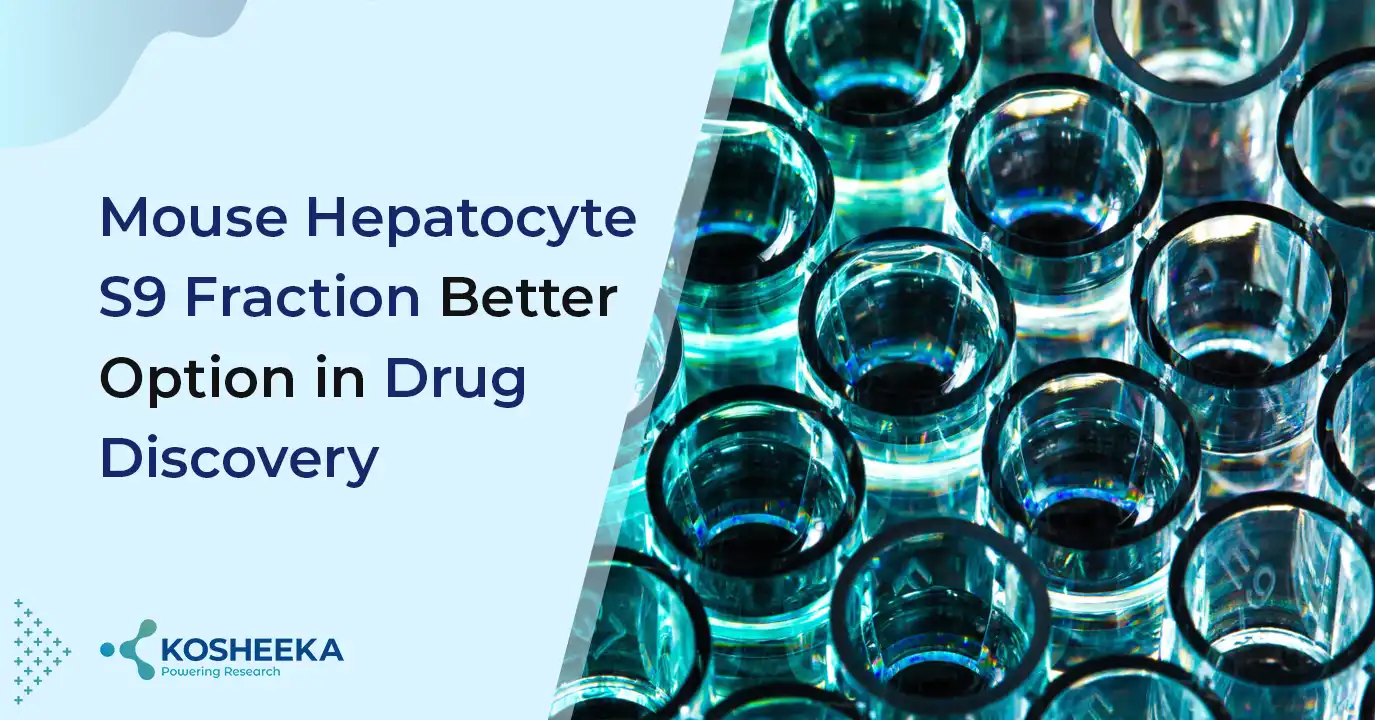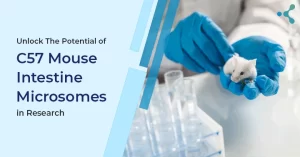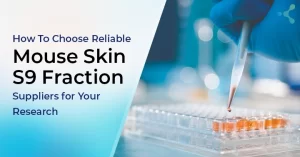Over the decades, the discovery of new drugs has revolutionized our understanding of diseases and their treatment. At present, you may not imagine your life without medications and supplementations.
So, in short, medications have some role in adding quality to our lives.
With the advancement in medical research, different aspects have been employed in drug design and discovery research. One such approach is utilizing mouse hepatocyte S9 fraction.
The utilization of mouse S9 fractions in genotoxicity and drug research has gained considerable attention due to its potential advantages and implications for toxicological assessments. Mouse S9 fractions, similar to rat S9 fractions, serve as external metabolic activation systems in various in vitro assays, including the widely employed Ames’s test.
Optimizing ADME Studies in Drug Discovery: Leveraging Mouse Hepatocyte S9 Fractions for Efficient and Cost-Effective Metabolic Stability Assessments
In drug discovery, absorption, distribution, metabolism, and elimination (ADME) studies are crucial for enhancing the likelihood of success for new chemical entities as potential drug candidates. These studies aim to characterize the “drug-like” properties of compounds and facilitate decision-making in subsequent stages of drug development. To meet the demands of high throughput medicinal chemistry, ADME assays have evolved to accommodate rapid and reliable assessments while maintaining quality and cost efficiency.
A strategic approach to ADME assessment involves employing a tiered flowchart, starting with straightforward and cost-effective assays to quickly identify and eliminate inferior compounds. The metabolic stability screen stands as the initial ADME assessment for NCEs, offering insights into their potential for liver metabolic clearance in vivo. By prioritizing compounds based on metabolic stability early in the discovery process, researchers can streamline subsequent pharmacokinetic studies and structure-activity relationship (SAR) development.
Liver Subcellular Fractions for Enhanced Preclinical Research in Drug Metabolism Studies
In the realm of preclinical research aimed at delineating the ADME profile of drug candidates, utilizing mouse liver fractions stands as a cornerstone.
Mouse microsomes also emerge as pivotal reservoirs harboring elevated concentrations of crucial drug-metabolizing enzymes, notably cytochrome P450 (CYP) and UDP-glucuronosyltransferase (UGT) enzymes. Both homogenate and S9 fractions offer a blend of membranes and soluble enzymes, which can be further fractionated into cytosol and microsome subcellular fractions. These subcellular fractions play distinctive roles in drug metabolism studies.
Homogenate and S9 fractions exhibit a broad spectrum of phase I and phase II enzymes, rendering them suitable candidates for various PK/ADME investigations. On the other hand, microsomal fractions boast enrichment in phase I enzymes, offering a focused platform for scrutinizing initial metabolic transformations. Conversely, cytosolic fractions house an array of soluble drug-metabolizing enzymes, making them ideal for evaluating phase II metabolic reactions, especially following observations in S9 fractions.
In conclusion, the strategic utilization of mouse liver subcellular fractions enhances the precision and efficiency of preclinical research in drug metabolism studies. By harnessing the distinct attributes of homogenate, S9, microsomal, and cytosolic fractions, researchers can glean comprehensive insights into the metabolic fate of drug candidates, thus facilitating informed decision-making in drug development endeavors.
Product-Related Queries, Or Partnership Inquiries
Exploring Mouse S9 Fractions: Implications for Genotoxicity Research
Genotoxicity studies often require the evaluation of a compound’s ability to induce mutations in the genetic material of test organisms. The inclusion of metabolic activation systems like S9 fractions is crucial, as it mimics the metabolic processes that occur in mammalian cells, particularly in the liver, where many xenobiotic compounds are metabolized into reactive intermediates capable of causing DNA damage.
Advantages of mouse hepatocyte S9 fractions over rat and human hepatocyte S9 fractions
While rat-derived S9 fractions have been extensively utilized in genotoxicity testing, mouse hepatocyte S9 fractions offer several potential advantages. One notable advantage is the ability to explore species-specific differences in metabolic activation pathways. Since mice and rats exhibit variations in cytochrome P450 enzymes and other metabolic pathways, employing mouse S9 fractions can provide insights into the potential impact of species-specific metabolism on genotoxicity outcomes.
Additionally, the use of mouse S9 fractions aligns with efforts to reduce reliance on animal models and promote the principles of the 3Rs (Replacement, Reduction, Refinement) in toxicological research. And using human hepatocyte S9 fractions concerned with ethics. By utilizing S9 fractions derived from mouse liver homogenates, researchers can reduce the number of live animals required for experimentation while still obtaining relevant metabolic activation data.
In conclusion, the use of mouse S9 fractions in genotoxicity research presents opportunities to enhance our understanding of species-specific metabolic pathways and improve the relevance and reliability of toxicity testing. By leveraging mouse models and S9 fractions, researchers can gain valuable insights into the mechanisms underlying genotoxicity and contribute to the development of safer chemicals and pharmaceuticals.
Ensure Optimal Activation of Mouse Liver Microsomes and S9 Fractions for Enhanced Assay Performance
To maximize the effectiveness of assays employing microsomes and S9 fractions, it is crucial to ensure proper activation. For this purpose, one can use NADPH regeneration systems to support robust metabolic activity by maintaining adequate NADPH levels throughout the incubation process.
RapidStartTM, offers a convenient and efficient solution to this requirement.
RapidStartTM employs an enzymatic reaction that converts NADP to NADPH, a critical cofactor utilized by cytochrome P450 enzymes. This regenerated NADPH is then utilized in metabolic reactions and subsequently oxidized back to NADP, thereby sustaining a steady supply of NADPH throughout the incubation period. This continuous cycle ensures stable metabolic activity, leading to consistent and reliable assay results.
Activation of RapidStartTM NADPH regeneration is straightforward, requiring only the addition of water. This user-friendly feature allows for easy customization of the system’s capability by simply adjusting the amount of water added, making it suitable for both short- and long-term incubations. Whether utilizing recombinant enzymes or subcellular fractions, RapidStartTM facilitates the generation of accurate and reproducible data during in vitro assays.
Liver S9 fraction assay in the drug discovery process
In vitro, high throughput screening drug discovery plays a pivotal role in guiding lead optimization and mitigating the selection of candidates with unfavorable properties. Liver S9 fractions, obtained from the supernatant of liver homogenates, offer a versatile and informative system for metabolic stability evaluations. Unlike liver microsomes, which primarily contain endoplasmic reticulum subcellular fractions, S9 fractions encompass both microsomal and cytosolic enzymes, providing a comprehensive representation of Phase I and Phase II metabolic pathways(PMID: 15053006).
While liver S9 fractions require exogenous cofactors for activity, they offer significant advantages, including ease of use, storage, and cost-effectiveness. Moreover, they eliminate the need for additional complexity associated with hepatocyte-based assays, making them ideal for high throughput screening and mechanistic studies with inhibitors. The metabolic activity of S9 fractions can be assessed using prototypic substrates such as 7-ethoxycoumarin, which serves as a measure of cytochrome P450 enzyme activity(PMID: 14599475).
A retrospective analysis comparing liver S9 assays to hepatocyte and microsomal assays demonstrated that liver S9 fractions provide robust and comparable data to hepatocytes but in a more efficient and cost-effective manner. Additionally, microsomal assays did not offer any selection advantage over S9 assays for the compounds tested and lacked the ability to provide insights into Phase II metabolism(PMID: 26902079).
Conclusion
In conclusion, mouse hepatocyte S9 fractions emerge as a valuable tool for metabolic stability assessments in drug discovery, offering researchers a reliable, rapid, and cost-effective solution for early-stage ADME screening. By leveraging the versatility and efficiency of liver S9 assays, researchers can expedite the identification of promising drug candidates while minimizing costs and resources. However, it is essential to acknowledge potential limitations and considerations associated with the use of mouse S9 fractions. Variability in metabolic activity among individual mice and strains, similar to what is observed with rat S9 fractions, may necessitate careful standardization and quality control measures to ensure reproducibility and reliability of results.
Moreover, researchers should carefully evaluate the suitability of mouse hepatocyte S9 fractions for specific experimental objectives, considering factors such as the target species for toxicity assessment, the metabolic pathways involved in compound activation, and the availability of appropriate genetically modified mouse models.



